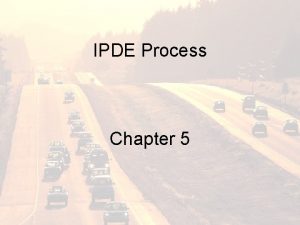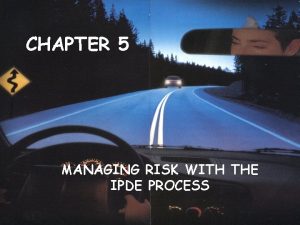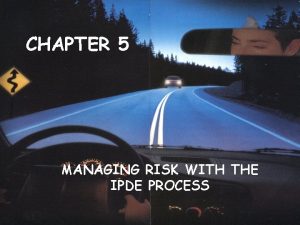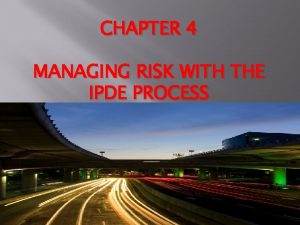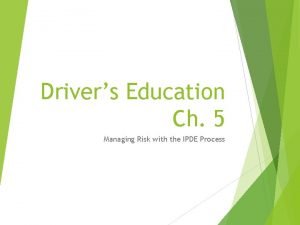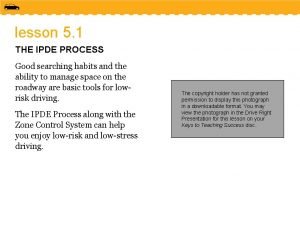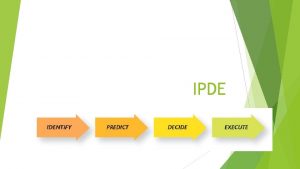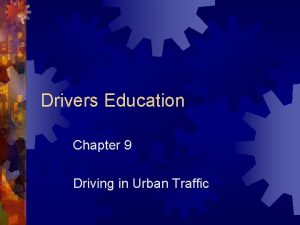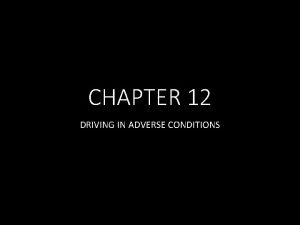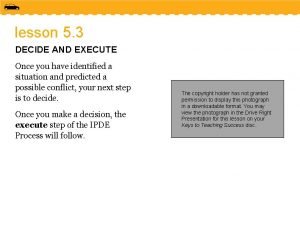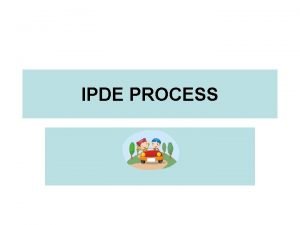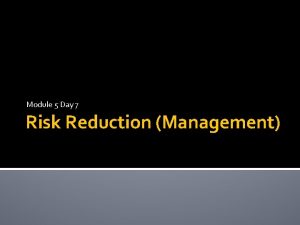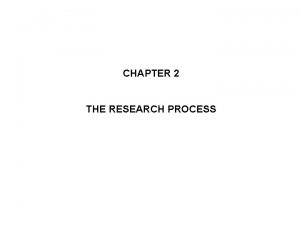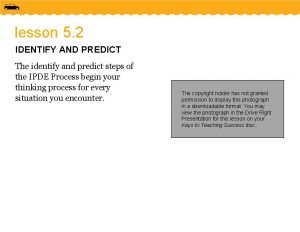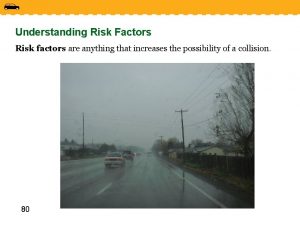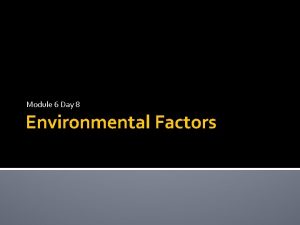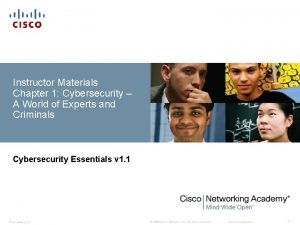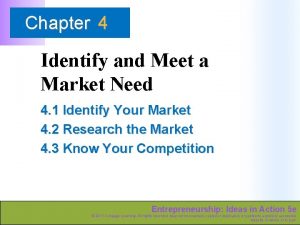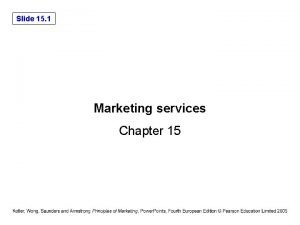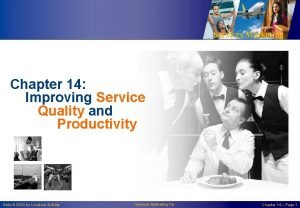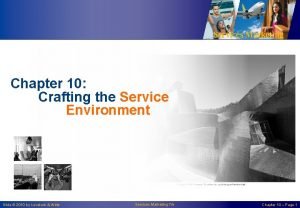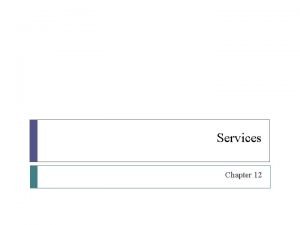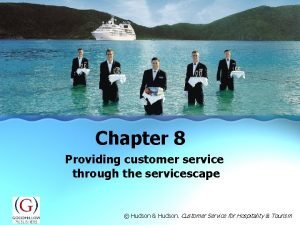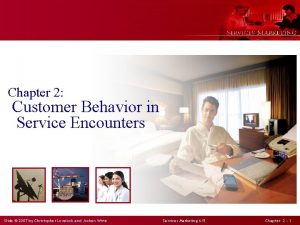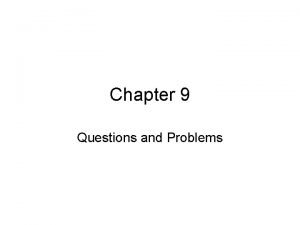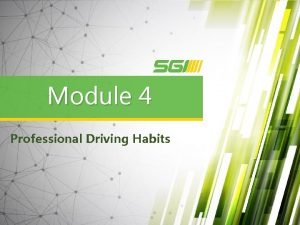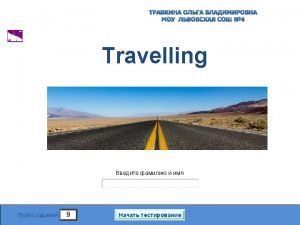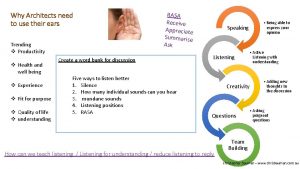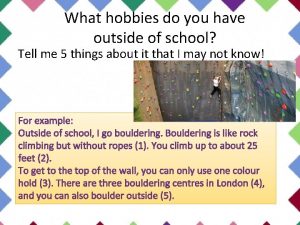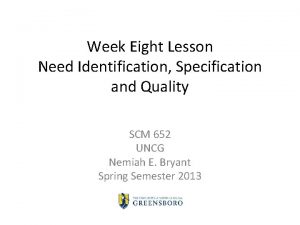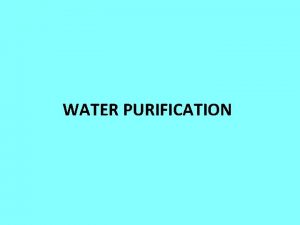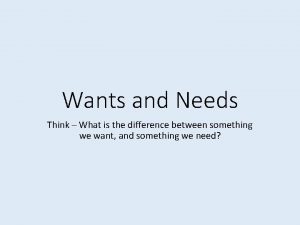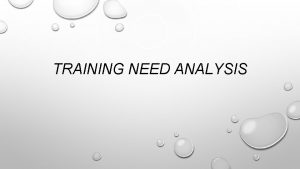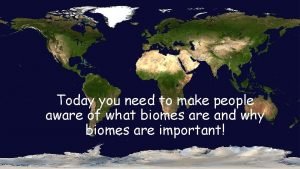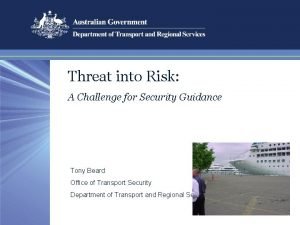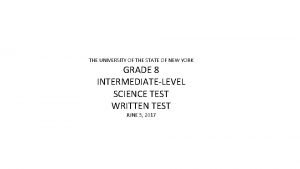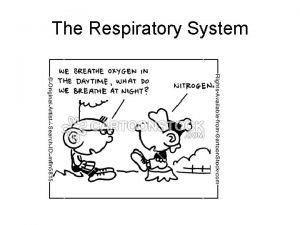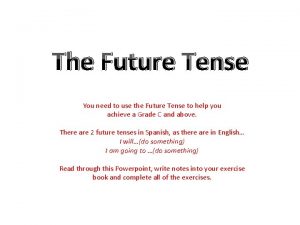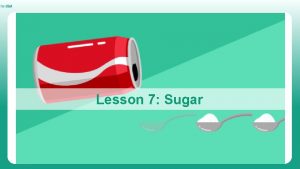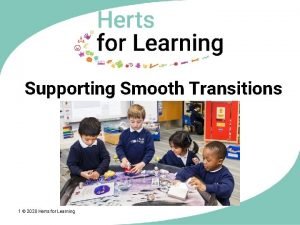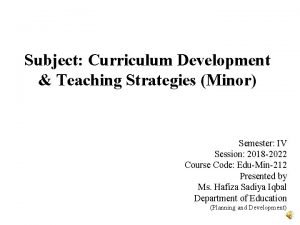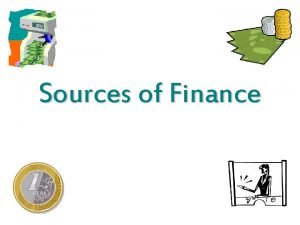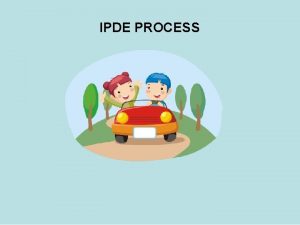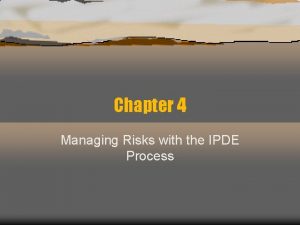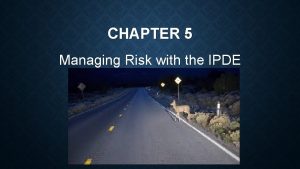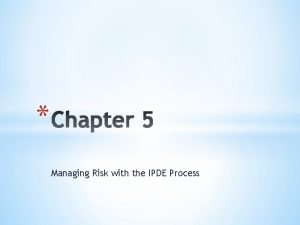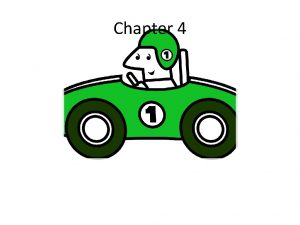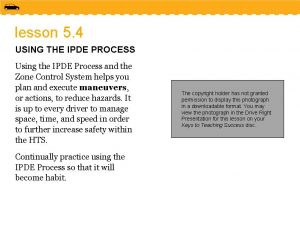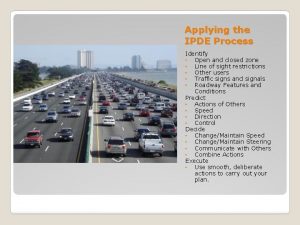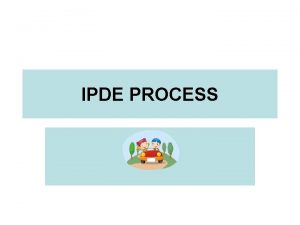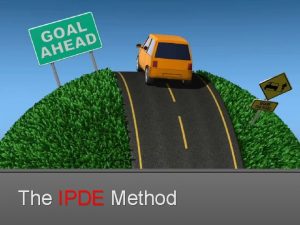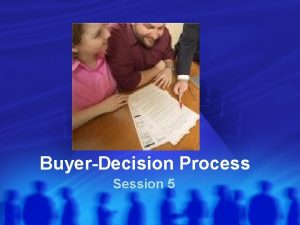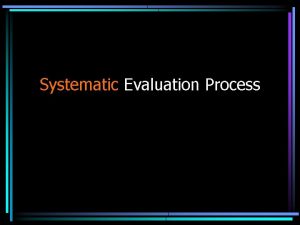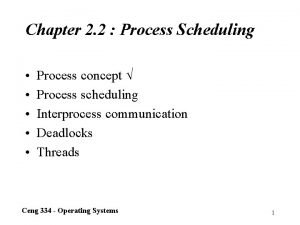IPDE Process Chapter 5 IPDE Process Need an




















































- Slides: 52

IPDE Process Chapter 5

IPDE Process • Need an organized system of seeing thinking and responding. • Better equipped to manage risk • Reduce possibility of damage or harm

Risk • All activities • Driving = high degree of risk • Contributing factors – Driver – Vehicle – Roadway – Environment

Teen risk Statistics • In 2013, 2, 163 teens in the United States ages 16– 19 were killed and 243, 243 were treated in emergency departments for injuries suffered in motor vehicle crashes. • That means that six teens ages 16– 19 died every day from motor vehicle injuries.

Who is most at risk • Males: In 2013, the motor vehicle death rate for male drivers and passengers ages 16 to 19 was almost two times that of their female counterparts. 1 • Teens driving with teen passengers: The presence of teen passengers increases the crash risk of unsupervised teen drivers. This risk increases with the number of teen passengers. 4, 5 • Newly licensed teens: Crash risk is particularly high during the first months of licensure. 6, 7

Driver-contributed factors • • • Adjusting radio Being angry Having blurred vision Combing hair Drinking while driving Using cell phone

Vehicle-contributed factors • • • Bald tires Poorly adjusted brakes Dirty windshield Broken headlights Worn wiper blades

Roadway and environmentcontributed factors • • • Bright sun Construction Dark shadows Snow and ice Sharp curve

Managing Risk Make sure nothing about your own condition or the condition of the vehicle raise your level of risk. Good drivers make every effort to manage risk in order to lower probability of conflict.

Managing Risk Develop low-risk driving behaviors now, as these will become your safe driving habits later.

The IPDE Process • IPDE Process, • Smith System and • Zone Control System • can enable you to enjoy low-risk and lowstress driving. • Safe driving depends upon your ability to see and analyze traffic situations correctly.

IPDE Process • DEFINITION: – Organized system of seeing, thinking and responding • 4 steps – Identify – Predict – Decide – Execute

Identify Use visual search pattern to identify • • • Open and closed zones Specific clues Other users Roadway features and conditions Traffic controls

Predict Use knowledge, judgment, and experience • • Actions of other users Speed Direction Control

Decide to use one or more actions to • Change or maintain speed • Change direction • Communicate

Execute your decisions to • • Control speed Steer Communicate Combine actions

Zone Control System • DEFINITION: – Organized method for managing 6 zones of space surrounding your vehicle • Allows you to see and respond to changes in traffic environment


Zones and Searching Ranges • OPEN ZONE—space where you can drive without a restriction to your line of sight or intended path of travel. • LINE OF SIGHT—distance you can see ahead in the direction you are looking

Zones and Searching Ranges • CLOSED ZONE—is a space not open to you because of a restriction in your line of sight or intended path of travel – Red light – Parked vehicle to right – Vehicle following to closely • Sooner identify better chance to respond

Zones and Searching Ranges • PATH OF TRAVEL—space your vehicle will occupy • TARGET AREA—section of the roadway where the target is located in the center of your intended path, and the area to the right and left.

Zones and Searching Ranges • TARGET AREA RANGE – 1 st searching range – Space from vehicle to the target area – Detect early any conditions that might affect intended path of travel

Zones and Searching Ranges • 12 -15 SECOND RANGE— – Space you will travel in during the next 12 - 15 seconds – Identify changes in your line of sight or path of travel to make decisions about controlling your intended path

Zones and Searching Ranges • 4 -6 SECOND RANGE – Space you will travel in the next 4 -6 seconds – Final update of how you are controlling your intended path of travel

Where and How to Look • FIELD OF VISION—area you can see around you, while looking straight ahead • CENTRAL VISION—area you can see clearly and sharply – 10 degrees • PERIPHERAL VISION—area to the left and right of central vision

Smith System • • • Aim high in steering Keep your eyes moving Get the big picture Make sure others see you Leave yourself an “out”

Aim High in Steering • 12 -15 seconds ahead • Far ahead to identify clues and analyze situations before zone becomes closed • What are some restriction to your line of sight that can cause a closed zone? – (pg 68)

Keep Your Eyes Moving • Look near, far, right, left, in mirrors • Fixate on object or event for an instant in order to identify it. • SCANNING—glancing continually and quickly with very brief fixations through your orderly visual search pattern

Get the Big Picture • Mental process of putting together the critical clues you have selected.

Selective Seeing • Identify and select clues and events that restrict your line of sight or change your intended path of travel

What to Look For • Other roadway users – Movement of other users, pedestrians, and bicyclists – GROUND VIEWING -- quick glances to roadway in front of your vehicle • Where front wheel heading – Problem drivers

What to Look For • Roadway features and conditions – Intersections, hills, curves – Lane reduction – Road construction – Width of lane – Road surface – Roadside hazards • Traffic Controls

What to do with info • Interpret the information you have identified. • Faced with more than one hazard/conflict = more complex predicting • Improve with knowledge and experience

What to do with info Use knowledge, judgment, and experience • Knowledge = laws, experience • Judgment = measuring, comparing, and evaluating • Experience = improve ability to predict

What to predict Actions of other roadway users • • Path Action Space Point of conflict

What to predict Control of your vehicle and possible consequences • Speed • TRACTION—requirement for control – Gripping power between tires and surface of road

Decide 1. Change or maintain speed – Decelerate, brake, or accelerate

Decide 2. Change direction • Move right or left – Space cushion • Area of space all around your vehicle

Lane Positions • Lane position 1 – Centered • Lane position 2 – 3 to 6 inches from left line • Lane position 3 – 3 -6 inches from right line

Decide 3. Communicate • • • Lights: head, tail, and brake Turn signals Parking lights and hazards Horn Car position Eye contact

Traffic flow • Safest position = fewest cars surround you • Manage time, space, and distance

Safe path of travel 1. Minimize hazard • Put more distance between yourself and the hazard 2. Separate hazard • Adjust speed to deal with one at a time 3. Compromise space • Give as much space possible to greater hazard

Execute • Physical skills used in driving • Most important actions: – Control speed – Steer – Communicate

Control speed • Check rear zone before decelerating • Be careful not to lock breaks – Impossible to steer – ABS system

Steer • Use just the amount of steering needed • Keep space cushions

Communicate • Using: – Headlights, taillights, and brake lights – Turn-signals • 3 -5 seconds before – Parking lights and hazards – Back-up lights – Horn – Vehicle position – Eye contact and body movement

It is up to every driver to manage space, time and speed in order to further increase safety within the HTS.

Commentary Driving • System of thinking out loud as you practice the IPDE Process • Verbalize what you identify, predict and decide


Selective use of the IPDE Process • Conditions change and you need to begin a new cycle before completing one

Factors that can cause the IPDE process to take more time • Complex traffic situations • Feelings of driver • Physical condition of driver

Review Questions • What does IPDE stand for and give example of each step? • Define – Field of vison – Line of sight – Open zone Space cusion Target area Scanning
 Orderly visual search pattern
Orderly visual search pattern Orderly visual search pattern
Orderly visual search pattern Chapter 1 managing risk when driving
Chapter 1 managing risk when driving Ipde process definition
Ipde process definition An orderly visual search pattern
An orderly visual search pattern Chapter 4 managing risk with the ipde process
Chapter 4 managing risk with the ipde process The four step in the ipde process are
The four step in the ipde process are Orderly visual search pattern
Orderly visual search pattern 2. how can you best use the ipde process in city driving?
2. how can you best use the ipde process in city driving? Adverse conditions light
Adverse conditions light Lane positions
Lane positions Compromise space
Compromise space Write the terms associated with ipde process
Write the terms associated with ipde process How can you best use the ipde process in city driving
How can you best use the ipde process in city driving What processes are crucial to the ipde process
What processes are crucial to the ipde process Define orderly visual search pattern
Define orderly visual search pattern Making safe driving decisions the ipde process
Making safe driving decisions the ipde process How can you best use the ipde process in city driving
How can you best use the ipde process in city driving Need recognition process
Need recognition process Chapter 1: cybersecurity - a world of experts and criminals
Chapter 1: cybersecurity - a world of experts and criminals Need a service chapter 5
Need a service chapter 5 Identify and meet a market need
Identify and meet a market need Need a service chapter 15
Need a service chapter 15 Need a service chapter 14
Need a service chapter 14 Russell model affect service marketing
Russell model affect service marketing The basic systems and services of a city
The basic systems and services of a city The servicescape
The servicescape Difference between high contact and low contact services
Difference between high contact and low contact services Payback ch 9
Payback ch 9 What are the parts of the highway transportation system
What are the parts of the highway transportation system What is the ipde defensive driving formula?
What is the ipde defensive driving formula? It can be quite busy here during the tourist
It can be quite busy here during the tourist Why architects need to use their ears
Why architects need to use their ears 5 hobbies you need
5 hobbies you need Need identification and specification
Need identification and specification Need of water purification
Need of water purification Needs vs wants examples
Needs vs wants examples Stabilization of transistor
Stabilization of transistor What do you mean by the term accountancy of lawyers
What do you mean by the term accountancy of lawyers Oh my.love my darling
Oh my.love my darling Training need analysis adalah
Training need analysis adalah We need to make people aware
We need to make people aware You only need to be lucky once
You only need to be lucky once Shylock
Shylock What do the rabbit, fungus, and tree have in common? *
What do the rabbit, fungus, and tree have in common? * Why do we need to breathe
Why do we need to breathe Passive with infinitive
Passive with infinitive Translate
Translate Do we need sugar
Do we need sugar Apa format without title page
Apa format without title page Transition level of need tool
Transition level of need tool Aim and objectives of curriculum
Aim and objectives of curriculum Sources of finance
Sources of finance
